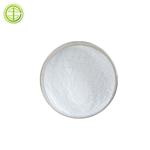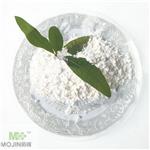CalciuM polycarbophil
- Product NameCalciuM polycarbophil
- CAS9003-97-8
- MF(C20H18Ca4O18)mult
- MW0
- EINECS1308068-626-2
- MOL FileMol File
Chemical Properties
| solubility | Polycarbophil polymers do not dissolve in water but can swell in water to around 1000 times their original volume (and ten times their original diameter) to form gels when exposed to a pH environment above 4–6. Since the pKa of these polymers is 6.0±0.5, the carboxylate groups on the polymer backbone ionize, resulting in electrostatic repulsion between the negative particles, which extends the molecule, adding to the swelling of the polymer. |
| form | Solid |
| color | White to off-white |
Usage And Synthesis
Polycarbophil occurs as fluffy, white to off-white, mildly acidic
polymer powder with slightly acetic odor.
Polycarbophils are synthetic, high-molecular-weight, crosslinked
polymers of acrylic acid. These poly(acrylic acid) polymers are
crosslinked with divinyl glycol. They are synthesized via precipitation
polymerization in ethyl acetate and then dried.
Conventionally, polycarbophil is used as a thickening agent at very
low concentrations (less than 1%) to produce a wide range of
viscosities and flow properties in topical lotions, creams, and gels, in
oral suspensions, and in transdermal gel reservoirs. It is also used as
an emulsifying agent in topical oil-in-water systems.
Polycarbophil is an excellent bioadhesive in buccal, ophthalmic, intestinal, nasal, vaginal, and rectal applications. Buccal tablets prepared using polycarbophil have shown high bioadhesive force and prolonged residence time, and proved to be nonirritative in in vivo trials with human buccal mucosa.Polycarbophil has been used in combination with hydroxypropyl methylcellulose to develop a bilayered buccal bioadhesive film formulation of nicotine hydrogen tartrate for smoking cessation therapy.It is also useful in designing controlled-release formulations and for drugs that undergo first-pass metabolism.Polycarbophil buccoadhesive disks have also been developed in formulations increasing the bioavailability and transmucosal absorption of poorly watersoluble drugs.Sublingual tablets of buprenorphine formulated using polycarbophil have shown superior mucoadhesive strength when compared to those using carbomer.
Polycarbophil gels have been used for delivering bioactive substances for local application to gingival,oropharyngeal and periodontal areas, and also for ocular drug delivery. The nasal retention of plasmid DNA is highly prolonged with the use of polycarbophil as the gelling agent. Polycarbophil has also been used to design an insulin liquid suppository for rectal application.A vaginal gel of econazole has shown improved therapeutic benefit on topical application in vaginal candidiasis. An intravaginal administration of polycarbophil gel alone and with carbomer is associated with improved signs of bacterial vaginosis. Polycarbophil with carboxymethylcellulose sodium are the polymers of choice for the formulation of an acid-buffering bioadhesive vaginal tablet of clotrimazole and metronidazole. Mucoadhesive vaginal vaccine delivery systems using polycarbophil have proved to be effective in the induction of mucosal and systemic immune responses.Polycarbophil gels have been used to deliver granulocyte-macrophage colony-stimulating factor (GM-CSF) effectively to genital preneoplastic lesions.Polycarbophil microspheres have been formulated for drug delivery to oral and nasal cavities. Floating-bioadhesive microspheres coated with polycarbophil have been found to be a useful gastroretentive drug delivery system for the treatment of Helicobacter pylori.
Conjugation with L-cysteine (thiolated polycarbophil) greatly enhances the mucoadhesive properties of polycarbophil and can be used as a platform for oral and nasal polypeptide delivery (e.g. heparin, human growth hormone,insulin,antigens for oral protein vaccination and for ocular and transdermal drug delivery systems.These compounds have shown higher stability and more controlled drug release. They have also been reported to act as a permeation enhancer by triggering the reversible opening of the tight junctions between the cells, thereby allowing the paracellular transport of peptides, in addition to locally deactivating the most important enzymes of the gastrointestinal tract.Due to its likelihood for inhibiting Pglycoprotein, thiolated polycarbophil has demonstrated improved bioavailability of an oral paclitaxel formulation.
Polycarbophil is an excellent bioadhesive in buccal, ophthalmic, intestinal, nasal, vaginal, and rectal applications. Buccal tablets prepared using polycarbophil have shown high bioadhesive force and prolonged residence time, and proved to be nonirritative in in vivo trials with human buccal mucosa.Polycarbophil has been used in combination with hydroxypropyl methylcellulose to develop a bilayered buccal bioadhesive film formulation of nicotine hydrogen tartrate for smoking cessation therapy.It is also useful in designing controlled-release formulations and for drugs that undergo first-pass metabolism.Polycarbophil buccoadhesive disks have also been developed in formulations increasing the bioavailability and transmucosal absorption of poorly watersoluble drugs.Sublingual tablets of buprenorphine formulated using polycarbophil have shown superior mucoadhesive strength when compared to those using carbomer.
Polycarbophil gels have been used for delivering bioactive substances for local application to gingival,oropharyngeal and periodontal areas, and also for ocular drug delivery. The nasal retention of plasmid DNA is highly prolonged with the use of polycarbophil as the gelling agent. Polycarbophil has also been used to design an insulin liquid suppository for rectal application.A vaginal gel of econazole has shown improved therapeutic benefit on topical application in vaginal candidiasis. An intravaginal administration of polycarbophil gel alone and with carbomer is associated with improved signs of bacterial vaginosis. Polycarbophil with carboxymethylcellulose sodium are the polymers of choice for the formulation of an acid-buffering bioadhesive vaginal tablet of clotrimazole and metronidazole. Mucoadhesive vaginal vaccine delivery systems using polycarbophil have proved to be effective in the induction of mucosal and systemic immune responses.Polycarbophil gels have been used to deliver granulocyte-macrophage colony-stimulating factor (GM-CSF) effectively to genital preneoplastic lesions.Polycarbophil microspheres have been formulated for drug delivery to oral and nasal cavities. Floating-bioadhesive microspheres coated with polycarbophil have been found to be a useful gastroretentive drug delivery system for the treatment of Helicobacter pylori.
Conjugation with L-cysteine (thiolated polycarbophil) greatly enhances the mucoadhesive properties of polycarbophil and can be used as a platform for oral and nasal polypeptide delivery (e.g. heparin, human growth hormone,insulin,antigens for oral protein vaccination and for ocular and transdermal drug delivery systems.These compounds have shown higher stability and more controlled drug release. They have also been reported to act as a permeation enhancer by triggering the reversible opening of the tight junctions between the cells, thereby allowing the paracellular transport of peptides, in addition to locally deactivating the most important enzymes of the gastrointestinal tract.Due to its likelihood for inhibiting Pglycoprotein, thiolated polycarbophil has demonstrated improved bioavailability of an oral paclitaxel formulation.
Polycarbophil polymers have a long history of safe and effective use
in topical gels, creams, lotions, and ointments. They have been
shown to have extremely low irritancy properties and are
nonsensitizing with repeated usage.
The use of these polymers is supported by extensive toxicological studies.
(guinea pig, oral): 2.0 g/kg
(mouse, IP): 0.039 g/kg
(mouse, IV): 0.070 g/kg
(mouse, oral): 4.6 g/kg
(rat, oral): >2.5 g/kg
(rabbit, skin): >3.0 g/kg
Chronic oral toxicity No significant effects in rats or dogs were observed after being fed with resin as 5% of the diet for 6? months.
The use of these polymers is supported by extensive toxicological studies.
(guinea pig, oral): 2.0 g/kg
(mouse, IP): 0.039 g/kg
(mouse, IV): 0.070 g/kg
(mouse, oral): 4.6 g/kg
(rat, oral): >2.5 g/kg
(rabbit, skin): >3.0 g/kg
Chronic oral toxicity No significant effects in rats or dogs were observed after being fed with resin as 5% of the diet for 6? months.
Polycarbophil polymers are stable, hygroscopic materials. They do
not undergo hydrolysis or oxidation under normal conditions. Heat
aging at temperatures below 104°C for up to 2 hours does not affect
the efficiency of the dry polymer. However, prolonged exposure to
excessive temperatures can result in discoloration, reduced stability,
and in some cases plasticization of the polymer. Complete
decomposition occurs with heating for 30 minutes at 260°C.
Polycarbophil polymers do not support bacteria, mold, or fungal growth in dry powder form. Microbial growth may occur in mucilages of the polymer solution. Although the gel properties are not affected by such growth, this phenomenon is usually unacceptable. The addition of appropriate preservatives prevents mold and bacterial growth in these mucilages. Mucilages and emulsions containing these polymers are stable under freeze–thaw conditions but exposure to high temperatures results in a drop in viscosity.
Polycarbophil polymers are very hygroscopic and should be packed in airtight, corrosion-resistant containers. They should be stored in a cool, dry place, and the container should be kept closed when not in use. Moisture pickup does not affect the efficiency of the resins, but resin containing high levels of moisture is more difficult to disperse and weigh accurately. Glass, plastic, or resinlined containers are recommended for products containing polycarbophil. Packaging in aluminum tubes usually requires formulations to have a pH less than 6.5, and packaging in other metallic tubes or containers necessitates a pH greater than 7.7 to prolong polycarbophil stability.
Polycarbophil polymers do not support bacteria, mold, or fungal growth in dry powder form. Microbial growth may occur in mucilages of the polymer solution. Although the gel properties are not affected by such growth, this phenomenon is usually unacceptable. The addition of appropriate preservatives prevents mold and bacterial growth in these mucilages. Mucilages and emulsions containing these polymers are stable under freeze–thaw conditions but exposure to high temperatures results in a drop in viscosity.
Polycarbophil polymers are very hygroscopic and should be packed in airtight, corrosion-resistant containers. They should be stored in a cool, dry place, and the container should be kept closed when not in use. Moisture pickup does not affect the efficiency of the resins, but resin containing high levels of moisture is more difficult to disperse and weigh accurately. Glass, plastic, or resinlined containers are recommended for products containing polycarbophil. Packaging in aluminum tubes usually requires formulations to have a pH less than 6.5, and packaging in other metallic tubes or containers necessitates a pH greater than 7.7 to prolong polycarbophil stability.
Heat may be generated if polycarbophil comes into contact with
strong basic materials such as ammonia, sodium hydroxide,
potassium hydroxide, or strongly basic amines. Polycarbophil
polymers are not compatible with cationic polymers, strong acids,
and high levels of electrolytes, as electrolytes tend to reduce the
viscosity of polycarbophil-based gels.
Preparation Products And Raw materials
Raw materials
Related Product Information
PROMPT×
PROMPT
The What'sApp is temporarily not supported in mainland China
The What'sApp is temporarily not supported in mainland China
Cancel
Determine


